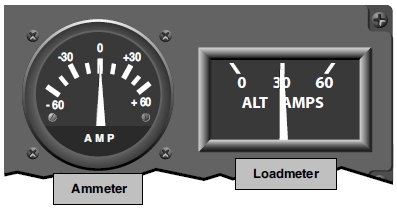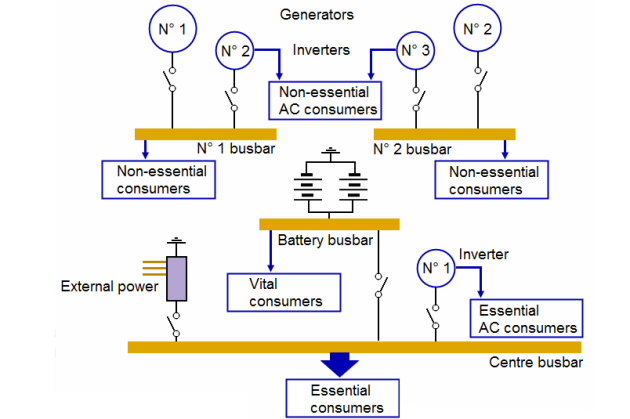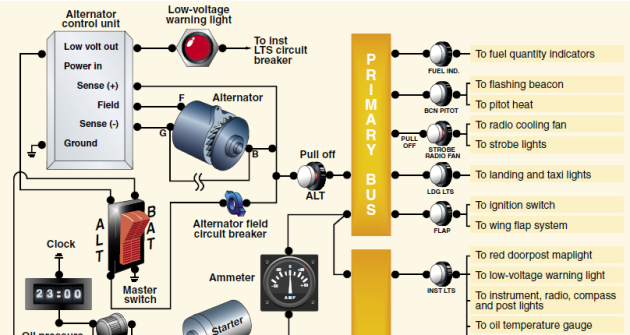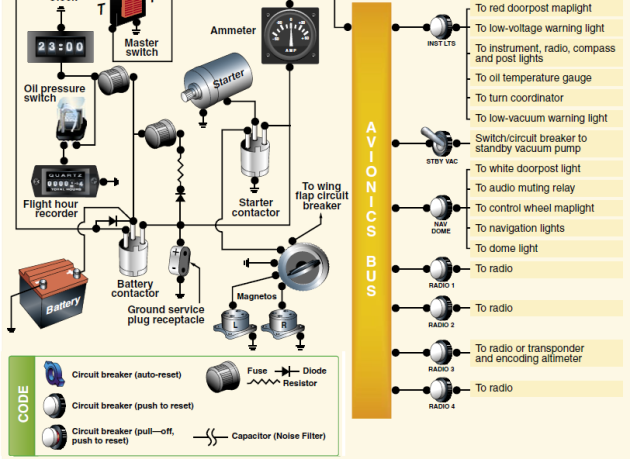DESCRIPTION AND OPERATION
The generation and conversion of power once accomplished requires a means of distributing it throughout the aircraft. Associated with the distribution function is the need to protect the electrical system from fault conditions. The general principle which applies to protection is that it is the busbar/distribution system which is protected and not the electrical service/load.
The prime aim of the protection is to minimize the loss of services and functions following a fault condition.
1. TYPICAL AIRCRAFT DC SYSTEM:
A generic distribution system is shown in Figure in this case a twin 28 V DC system is shown which might be typical for a twin-engined commuter aircraft.
The main elements of this electrical system are:
Two 28 V DC generators operating in parallel to supply No.1 and No.2 main DC busbars. These busbars feed the non-essential dc services.
Two inverters operate, one off each of the dc busbars to provide 115 V ac 400 Hz to non-essential AC services.
Both No.1 and No.2 busbars feed power to a centre or essential busbar which provides dc power for the aircraft essential dc services.
An inverter powered off this busbar feeds essential 115 V AC loads. A 28 V external power source may also feed this busbar when the aircraft is on the ground without the engines running.
The aircraft battery feeds the battery busbar from which are fed vital services. The battery may aiso be connected to the DCessential busbar if required.
To enable a system such as this to be afforded suitable protection requires several levels of power switching and protection:
Primary power generation protection of the type described earlier and which includes reverse current and under/over voltage protection under the control of the voltage regulator.
This controls the generator feed contactors which switch the generator output on to the No.1 / No. 2 de busbars.
2. TYPICAL ELECTRICAL POWER SYSTEM:
Most aircraft are equipped with either a 14V or a 28 V DC electrical system.
2.1. Reminders:
A basic aircraft electrical system consists of the following components:
Alternator/generator,
Battery,
Master/battery switch,
Alternator / generator switch,
Busbar, fuses, and circuit breakers,
Voltage regulator,
Ammeter / loadmeter,
Associated electrical wiring.
Engine-driven alternators or generators supply electric current to the electrical system. They also maintain a sufficient electrical charge in the battery. Electrical energy stored in a battery provides a source of electrical power for starting the engine and a limited supply of electrical power for use in the event the alternator or generator fails.
Most direct-current generators will not produce a sufficient amount of electrical current at low engine rpm to operate the entire electrical system. During operations at low engine rpm, the electrical needs must be drawn from the battery, which can quickly be depleted.
Alternators have several advantages over generators. Alternators produce sufficient current to operate the entire electrical system, even at slower engine speeds, by producing alternating current, which is converted to direct current. The electrical output of an alternator is more constant throughout a wide range of engine speeds.
2.2. General description of electrical power system:
Some aircraft have receptacles to which an external Ground Power Unit (GPU) may be connected to provide electrical energy for starting. These are very useful, especially during cold weather starting. Follow the manufacturer's recommendations for engine starting using a GPU.
The electrical system is turned on or off with a master switch. Turning the master switch to the ON position provides electrical energy to all the electrical equipment circuits except the ignition system. Equipment that commonly uses the electrical system for its source of energy includes:
Exterior lights( position lights, anticollision lights, landing lights, taxi lights)Interior cabin lights,Instrument lights,
Radio equipment,
Turn indicator,
Fuel gauges,
Electric fuel pump,
Stall warning system,
Pitot heat,
Starting motor.
Many aircraft are equipped with a battery switch that controls the electrical power to the aircraft in a manner similar to the master switch. In addition, an alternator switch is installed which permits the pilot to exclude the alternator from the electrical system in the event of alternator failure.
With the alternator half of the switch in the OFF position, the entire electrical load is placed on the battery. All nonessential electrical equipment should be turned off to conserve battery power.
A busbar is used as a terminal in the aircraft electrical system to connect the main electrical system to the equipment using electricity as a source of power. This simplifies the wiring system and provides a common point from which voltage can be distributed throughout the system.
Ammeter:
An ammeter is used to monitor the performance of the aircraft electrical system. The ammeter shows if the alternator/generator is producing an adequate supply of electrical power. It also indicates whether or not the battery is receiving an electrical charge.
Ammeters are designed with the zero point in the center of the face and a negative or positive indication on either side.
When the pointer of the ammeter is on the plus side, it shows the charging rate of the battery.
A minus indication means more current is being drawn from the battery than is being replaced.
A full-scale minus deflection indicates a malfunction of the alternator/generator.
A full-scale positive deflection indicates a malfunction of the regulator.

Loadmeter:
Another electrical monitoring indicator is a loadmeter.
This type of gauge has a scale beginning with zero and shows the load being placed on the alternator/generator. The loadmeter reflects the total percentage of the load placed on the generating capacity of the electrical system by the electrical accessories and battery.
When all electrical components are turned off, it reflects only the amount of charging current demanded by the battery.
Voltage regulator:
We have seen that a voltage regulator controls the rate of charge to the battery by stabilizing the generator or alternator electrical output.
The generator/alternator voltage output should be higher than the battery voltage.
For example, a 12-volt battery would be fed by a generator/alternator system of approximately 14 volts. The difference in voltage keeps the battery charged.


